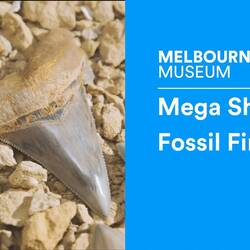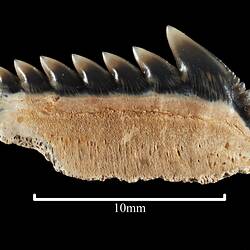This collection of shark teeth was collected near Jan Juc on the coast of Victoria. The first tooth was found in 2015 by local school teacher, Phil Mullaly. In December 2017 and January 2018 a team of Museums Victoria scientists excavated the site with Mr Mullaly and found over 40 teeth encased in a boulder.
The largest of the teeth found is over 7 cm long. Most of the teeth have been identified as being from a Great Jagged Narrow-toothed Shark, Carcharocles angustidens, that would have been alive about 25 million years ago.
The Great Jagged Narrow-toothed Shark could reach lengths of more than 9 metres, almost twice as long as the largest living shark, the Great White Shark, Carcharodon carcharias. Despite its size, it would have been dwarfed by the largest known shark, the Megalodon, Carcharodon megalodon, which lived from the Early Miocene to the end of the Pliocene (23 - 2.6 million years ago) and would probably have been about twice as large at 18 meters long. The Great Jagged Narrow-toothed Shark would still have been a top predator in the Oligocene (34 - 23 million years ago) seas and would have preyed on whales as well as smaller vertebrates.
Sharks lose and replace teeth continuously through their lives. Some species lose as many as one tooth a day. Each tooth at the front of the jaw has a series of teeth behind it ready to replace it when it falls out. Shark teeth vary in shape depending on the species' diet and method of feeding. This means shark species can often be identified from the shape of their teeth. The skeletons of sharks are mostly made of cartilage rather than bone so do not fossilise well. Teeth are the most commonly found parts of ancient sharks because they are the most likely part of the shark to fossilise and each shark produces so many of them.
While fossil shark teeth are not uncommon, this find from Jan Juc is rare because it contains multiple teeth from the same Carcharocles angustidens individual. There have only been two other similar groupings found anywhere in the world and this is the first in Australia.
The find is also unusual because it includes teeth from another type of shark, a species of sixgill shark, Hexanchus sp. These teeth seem to have come from many different sharks rather than one individual. Sixgill sharks still live around the coast of Victoria today. They are scavengers known to feed on the remains of whales and other animals. It is likely that these fossil sixgill shark teeth became detached while the sixgill sharks were scavenging on the carcass of the Great Jagged Narrow-toothed Shark.
More teeth and possibly part of the spinal column may remain in the cliff.
More Information
-
Keywords
-
Authors
-
Article types







